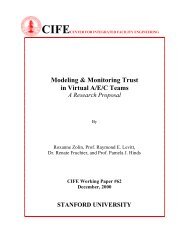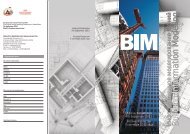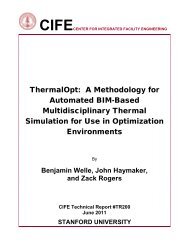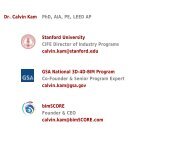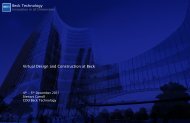Framework for Measuring Rationale Clarity of AEC Design Decisions
Framework for Measuring Rationale Clarity of AEC Design Decisions
Framework for Measuring Rationale Clarity of AEC Design Decisions
You also want an ePaper? Increase the reach of your titles
YUMPU automatically turns print PDFs into web optimized ePapers that Google loves.
<strong>Framework</strong> <strong>for</strong> <strong>Measuring</strong> Rational <strong>Clarity</strong><br />
Page 17 <strong>of</strong> 22<br />
Assertions that include uncertainties are not considered contradictory simply because they result<br />
in unlikely conclusions. For example, “There is only a 0.1% chance <strong>of</strong> an 8.5+ magnitude quake<br />
this year,” does not contradict “a 9.0 magnitude quake occurred this year” because there is an<br />
interpretation that supports both assertions (namely, that an unlikely but possible event has<br />
occurred).<br />
Correct/Incorrect<br />
Assertions that are both consistent and certain may be either correct or incorrect. Correct<br />
assertions are true in an absolute sense, meaning they are consistent with all other correct<br />
assertions; Contradictory data must contain at least one incorrect assertion. Although correctness<br />
is <strong>of</strong>ten difficult to assess, developing a rationale involves attempting to increase the degree <strong>of</strong><br />
correctness by checking assertions’ consistency against other certain assertions.<br />
Under this definition, all correct data is also certain. Fundamentally random (aleatory)<br />
uncertainties, like coin flip outcomes, can eventually be determined correct or incorrect.<br />
However, a probability distribution on outcomes cannot be determined correct or incorrect. For<br />
example, the occurrence <strong>of</strong> an 8.5 magnitude quake neither confirms nor negates the uncertain<br />
assertion “30% chance <strong>of</strong> magnitude 8+ quake within 20 years.” This definition <strong>of</strong> correctness<br />
agrees with the view <strong>of</strong> classical statistics (although not with views <strong>of</strong> quantum physics). Even<br />
aleatory uncertainties, like coin flip outcomes, are simple facts that can eventually be learned.<br />
Incorrect assertions can be credible if presented by a legitimated authority. Similarly, correct<br />
assertions may be viewed as dubious if they presented by an authority that lacks legitimacy.<br />
Discussion<br />
<strong>Design</strong> rationale is complex and fragile, and is typically understood and managed poorly in<br />
practice. This paper reviewed existing literature relevant to the measurement <strong>of</strong> clarity in <strong>AEC</strong><br />
<strong>Design</strong> Decision <strong>Rationale</strong>, and found no existing definition could portray the clarity <strong>of</strong>, and<br />
dependencies between, organizational actors and decision basis elements. The paper provided<br />
such a definition, the <strong>Rationale</strong> <strong>Clarity</strong> <strong>Framework</strong> (RCF) that views each relevant design<br />
assertion in two ways. First, the component <strong>of</strong> the rationale the assertion addresses, such as<br />
objectives, constraints, or options. Second, the conditions <strong>of</strong> clarity the assertion sustains, such<br />
as coherence, concreteness, and credibility. A complete rationale includes assertions addressing<br />
each component, and a clear rationale includes assertions that meet the conditions.<br />
We have found that conceptualizing project in<strong>for</strong>mation using RCF exposes the contributions<br />
and deficiencies <strong>of</strong> existing decision documentation methods. It creates a unified view suitable<br />
<strong>for</strong> developing organizational consensus within <strong>AEC</strong> organizations to improved process and<br />
product per<strong>for</strong>mance. RCF has implications <strong>for</strong> research and practice.<br />
Implications <strong>for</strong> Research<br />
A standard definition <strong>of</strong> rationale clarity can improve the ability <strong>of</strong> researchers to compare<br />
theories and methods, and enable the <strong>for</strong>mulation <strong>of</strong> testable propositions regarding the effects <strong>of</strong><br />
increasing clarity on <strong>AEC</strong> projects and industry.<br />
©2010 John Chachere & John Haymaker




